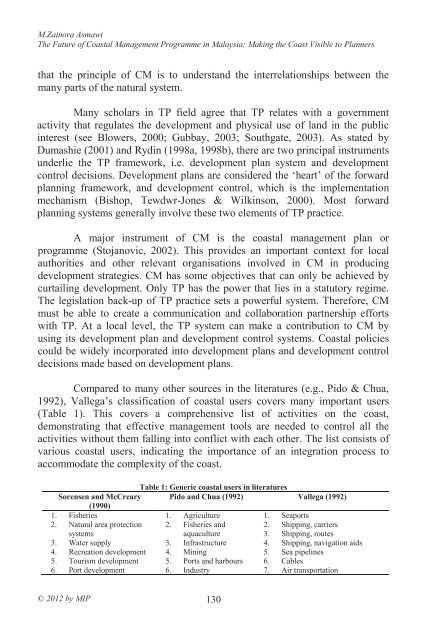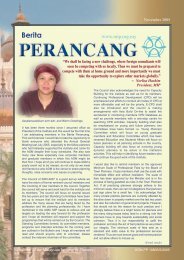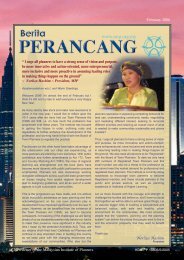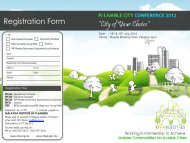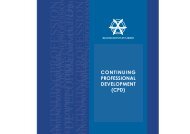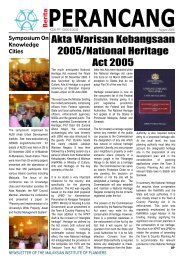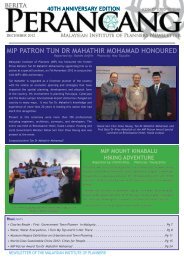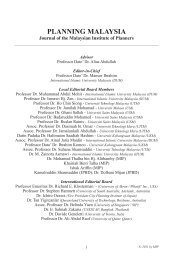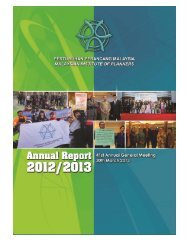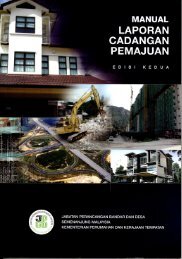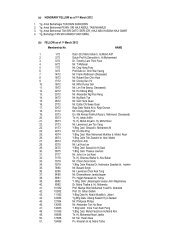Untitled - Malaysian Institute of Planners
Untitled - Malaysian Institute of Planners
Untitled - Malaysian Institute of Planners
You also want an ePaper? Increase the reach of your titles
YUMPU automatically turns print PDFs into web optimized ePapers that Google loves.
M.Zainora AsmawiThe Future <strong>of</strong> Coastal Management Programme in Malaysia: Making the Coast Visible to <strong>Planners</strong>that the principle <strong>of</strong> CM is to understand the interrelationships between themany parts <strong>of</strong> the natural system.Many scholars in TP field agree that TP relates with a governmentactivity that regulates the development and physical use <strong>of</strong> land in the publicinterest (see Blowers, 2000; Gubbay, 2003; Southgate, 2003). As stated byDumashie (2001) and Rydin (1998a, 1998b), there are two principal instrumentsunderlie the TP framework, i.e. development plan system and developmentcontrol decisions. Development plans are considered the ‘heart’ <strong>of</strong> the forwardplanning framework, and development control, which is the implementationmechanism (Bishop, Tewdwr-Jones & Wilkinson, 2000). Most forwardplanning systems generally involve these two elements <strong>of</strong> TP practice.A major instrument <strong>of</strong> CM is the coastal management plan orprogramme (Stojanovic, 2002). This provides an important context for localauthorities and other relevant organisations involved in CM in producingdevelopment strategies. CM has some objectives that can only be achieved bycurtailing development. Only TP has the power that lies in a statutory regime.The legislation back-up <strong>of</strong> TP practice sets a powerful system. Therefore, CMmust be able to create a communication and collaboration partnership effortswith TP. At a local level, the TP system can make a contribution to CM byusing its development plan and development control systems. Coastal policiescould be widely incorporated into development plans and development controldecisions made based on development plans.Compared to many other sources in the literatures (e.g., Pido & Chua,1992), Vallega’s classification <strong>of</strong> coastal users covers many important users(Table 1). This covers a comprehensive list <strong>of</strong> activities on the coast,demonstrating that effective management tools are needed to control all theactivities without them falling into conflict with each other. The list consists <strong>of</strong>various coastal users, indicating the importance <strong>of</strong> an integration process toaccommodate the complexity <strong>of</strong> the coast.Table 1: Generic coastal users in literaturesSorensen and McCreary Pido and C ua 1 Valle a 111. Fisheries1. Agriculture1. Seaports2. Natural area protection 2. Fisheries and 2. Shipping, carrierssystemsaquaculture3. Shipping, routes3. Water supply3. Infrastructure 4. Shipping, navigation aids4. Recreation development 4. Mining5. Sea pipelines5. Tourism development 5. Ports and harbours 6. Cables6. Port development6. Industry7. Air transportation© 2012 by MIP 130


